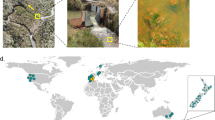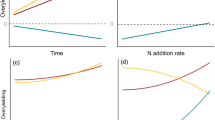Abstract
Replying to H. M. Baulch, E. H. Stanley & E. S. Bernhardt Nature 477, doi:10.1038/nature10418 (2011)
Over the last 20 years, 59 experiments have quantified how the richness of plants and algae influence concentrations of inorganic nitrogen in soil or water1. Of these, 86% have shown that the concentration of nitrogen decreases as biodiversity increases—by an average of 48%. The primary contribution of my study2 was to identify a biological mechanism that is likely to explain these biodiversity effects. Using stream mesocosms, I showed that the impacts of algal diversity on nitrogen dynamics are controlled by niche partitioning—a long presumed, but rarely demonstrated mechanism. Baulch, Stanley and Bernhardt3 have questioned whether my findings have any implications for managing water quality in ‘real’ streams, as I suggested. They argue that nitrogen assimilation by algae cannot influence long-term nitrogen retention due to high turnover of algal biomass and rapid recycling of nitrogen, and they suggest that the only permanent loss of nitrogen from a stream is via denitrification.
This is a preview of subscription content, access via your institution
Access options
Subscribe to this journal
Receive 51 print issues and online access
$199.00 per year
only $3.90 per issue
Buy this article
- Purchase on Springer Link
- Instant access to full article PDF
Prices may be subject to local taxes which are calculated during checkout
Similar content being viewed by others
References
Cardinale, B. J. et al. The functional role of producer diversity in ecosystems. Am. J. Bot. 98, 572–592 (2011)
Cardinale, B. J. Biodiversity improves water quality through niche partitioning. Nature 472, 86–89 (2011)
Baulch, H. M., Stanley, E. H. & Bernhardt, E. S. Can algal uptake stop NO3 − pollution? Nature 477 10.1038/nature10418 (2011)
Hall, R. O. et al. Nitrate removal in stream ecosystems measured by 15N addition experiments: total uptake. Limnol. Oceanogr. 54, 653–665 (2009)
Mulholland, P. J. et al. Nitrate removal in stream ecosystems measured by 15N addition experiments: denitrification. Limnol. Oceanogr. 54, 666–680 (2009)
Mulholland, P. J. et al. Stream denitrification across biomes and its response to anthropogenic nitrate loading. Nature 452, 202–205 (2008)
Dodds, W. K. et al. Quantification of the nitrogen cycle in a prairie stream. Ecosystems 3, 574–589 (2000)
Sanzone, D. M. et al. Carbon and nitrogen transfer from a desert stream to riparian predators. Oecologia 134, 238–250 (2003)
Nakano, S. & Murakami, M. Reciprocal subsidies: dynamic interdependence between terrestrial and aquatic food webs. Proc. Natl Acad. Sci. USA 98, 166–170 (2001)
Bernot, M. J. & Dodds, W. K. Nitrogen retention, removal, and saturation in lotic ecosystems. Ecosystems 8, 442–453 (2005)
Triska, F. J., Kennedy, V. C., Avanzino, R. J., Zellweger, G. W. & Bencala, K. E. Retention and transport of nutrients in a third-order stream in northwestern California: hyporheic processes. Ecology 70, 1893–1905 (1989)
Hall, R. O., Baker, M. A., Arp, C. D. & Koch, B. J. Hydrologic control of nitrogen removal, storage, and export in a mountain stream. Limnol. Oceanogr. 54, 2128–2142 (2009)
Ashkenas, L. R., Johnson, S. L., Gregory, S. V., Tank, J. L. & Wollheim, W. M. A stable isotope tracer study of nitrogen uptake and transformation in an old-growth forest stream. Ecology 85, 1725–1739 (2004)
Author information
Authors and Affiliations
Corresponding author
Rights and permissions
About this article
Cite this article
Cardinale, B. Cardinale reply. Nature 477, E3–E4 (2011). https://doi.org/10.1038/nature10419
Published:
Issue Date:
DOI: https://doi.org/10.1038/nature10419
This article is cited by
Comments
By submitting a comment you agree to abide by our Terms and Community Guidelines. If you find something abusive or that does not comply with our terms or guidelines please flag it as inappropriate.



